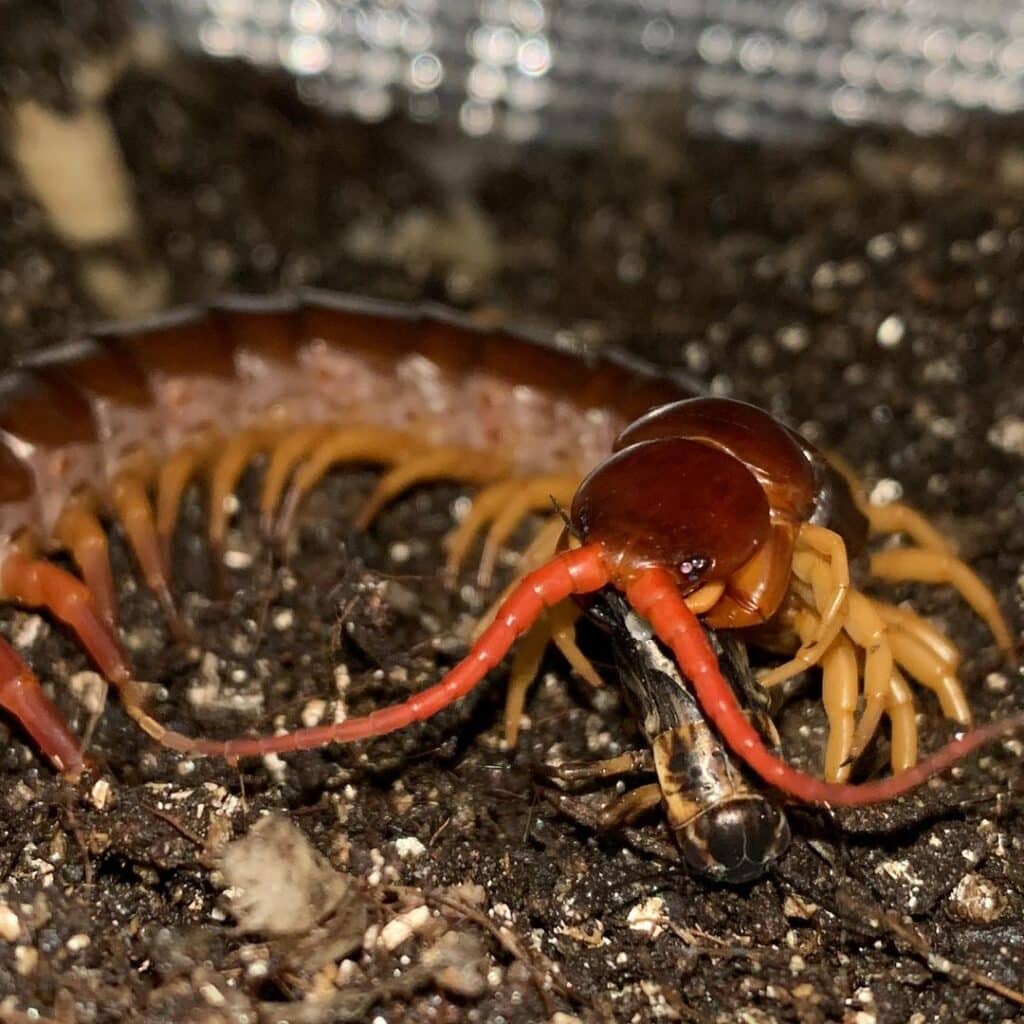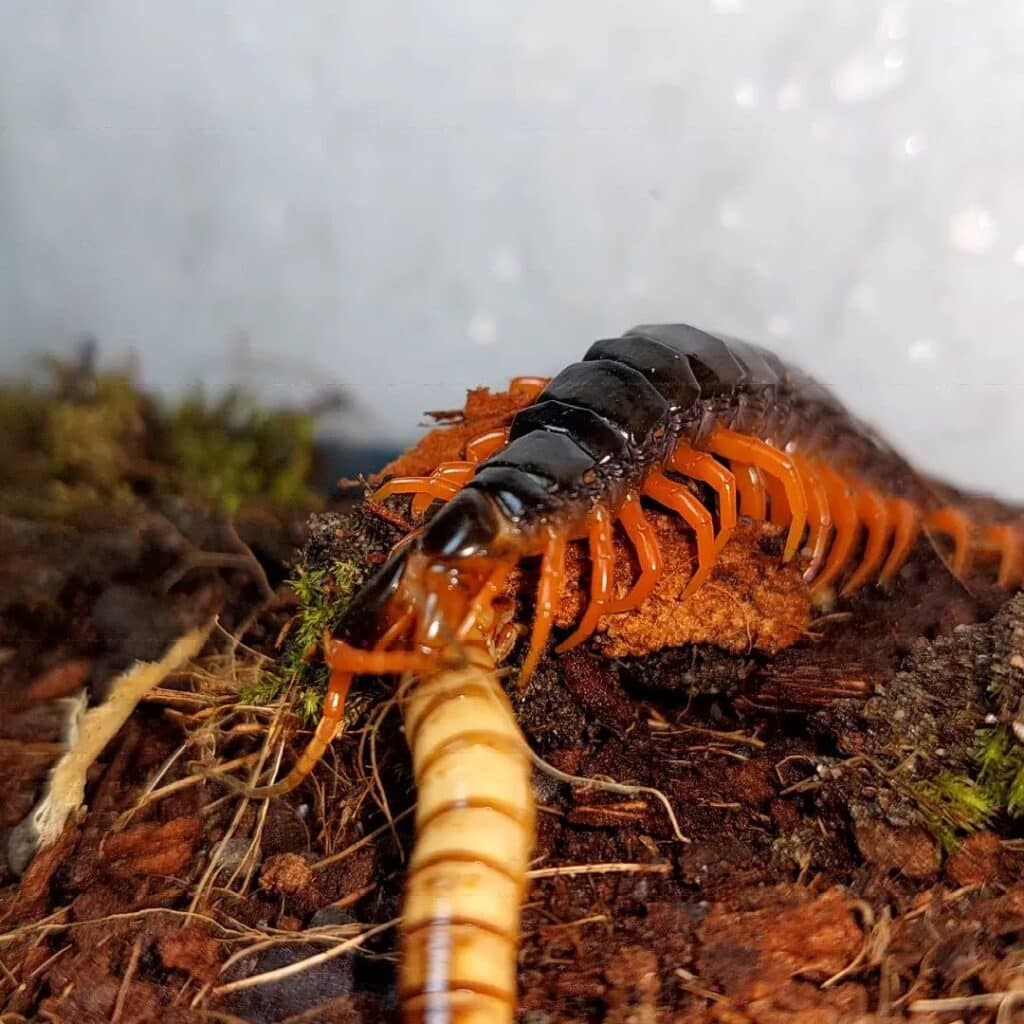Centipedes: Facts, Venom, Diet, Habitat
Centipedes are one of the very first animals to ever come about on our beloved planet, showing up in our fossil records as far back as 430 million years during the late-Silurian period. This means they pre-date dinosaurs by over 200 million years, and they’ve been quite successful in out-living them.
It is believed that the millipede, cousin to centipedes, appeared first on this earth, with the two separating lineages around…
Around this time, it wasn’t uncommon for specimens to grow over six feet in length. In fact, a centipede fossil discovered in 2021 was reported measuring six foot-three inches in length, and it measured 22 inches in width, which is nearly two feet.
What’s more, they are widely considered to be the first animals to ever venture out of the ocean and make their homes on land, doing so roughly 420 million years ago.
It’s quite remarkable it only took them about 10 million years to make this transition, but history, along with the number of centipedes in the world today have showcased this was a great choice made by their ancestors long ago.
It’s hard to imagine a centipede the size of a tall, grown man, they’re truly terrifying at their current size that rarely exceeds 12 inches in the biggest specimens.
They usually range anywhere from 1-to-12 inches in length, depending on the species.
There are an estimated 8,000 species of centipede that still exist in the world today, though only about 3,000 of them are currently recognized by science. That means scientists have only discovered about half the species of centipedes that actually exist.
The most common centipede, to most of us humans, is the house centipede.

House Centipedes
The house centipede originated in southern Europe, but were brought to the United States, as well as Mexico by unknowing people a few hundred years ago.
Many people will kill them just as they’d kill say flies that invade their homes, but this isn’t exactly the best approach to take, and we’ll tell you why.
House centipedes play an important role in keeping insects such as ants, roaches, flies, termites, amongst others at bay. Whatever unwelcome insects are in your home, house centipedes will kill and eat.
What’s more, on top of that, they rarely bite humans, and they do not harm or damage anything in your household such as plants.
So, should you see one in your home, it’s best to leave it be and let it do its thing. We understand this isn’t best case scenario for most, so if you must, you should transport it outside using a cup, rather than killing it.
Now that you know the important role of house centipedes, let’s get into the difference between centipedes and millipedes.
Centipede Anatomy
The main difference in these two species is the number of legs each has.
Centipedes, nor millipedes have an exact number of legs, as they grow a new pair of them each time they molt. They do however have one pair of legs (two legs) per body segment, while millipedes have two pairs of legs (four legs) per body segment.
Millipedes are also generally a more roundish, long cylinder-like shape, while centipedes are thinner and somewhat flatter looking.
Then we have the venom of centipedes; all centipedes are venomous, while millipedes are not, though some millipedes are poisonous.
The difference between poison and venom is that venom must be injected, while poison is either be absorbed through skin or eaten.
If you touch it and it kills you, or if you eat it and it kills you, it’s poisonous.
On the contrary, if you’re stung or bitten and it kills you, it’s venomous.
Centipede Venom
Being bitten by a centipede causes intense pain for all victims, with symptoms of their bites including local tissue swelling, redness around the affected area, swollen and painful lymph nodes, headaches, heart palpitations, nausea and vomiting, as well as anxiety and sometimes even death, though it is rare.
If you were to be bitten by a centipede, chances are you’d survive the attack.
However, if you were to die from it, you wouldn’t be the first; they have produced human fatalities before.
Their venom glands are attached to a pair of legs that have been modified into hypodermic fangs at the front of their bodies called toxicognaths.
This means they used to be just another pair of legs, but turned into fangs containing venom over millions and millions of years of evolution.
It’s quite extraordinary when you think about it.
Then we have their antennae, which are found on both ends of a centipedes body. This is another evolutionary trait they’ve adapted in order to confuse potential predators, confusing them as to which end is its head, the head that has lethal toxicognaths directly under it.
Another interesting fact about centipedes:
There are more spots on a king cobra that are safe to touch than on a centipede.
Of course king cobras are much more venomous than any centipede in the world today; however, a centipede can twist its body and wrap around your hand no matter where you touch it. Once one pair of its legs gets ahold of you, it’s a wrap, whereas with a king cobra, all you have to do is make sure its face cannot reach you.
Furthermore, if you are handling a centipede, it’s important you don’t give them the indication that you’re a living being, because if they think you’re more than say a tree branch, there’s a good chance you’ll get bitten.
It is extremely easy to set them off, they’re one of the more temperamental animals in the entire world, and they’re also ridiculously fast. Just something to keep in mind should you want to handle one at any point.
Range & Habitat
Centipedes live in parts of every continent on earth short of Antarctica, making them one of the most successful species this world has ever seen.
There are a recorded 70 centipede species native to Canada, 52 in Mexico, 43 in Cuba, 8 in Haiti and the Dominican Republic, 24 in Hispaniola, 37 in Colombia, 15 in Venezuela, a whopping 563 in Brazil, 32 in Northern Africa, 124 in Southern Africa, 8 in Tunisia, 6 in Yemen, 48 in Iraq, 9 in Saudi Arabia, 16 in Afghanistan, 8 in Southwestern Siberia, 41 in European Russia, 57 in Britain, 20 in Germany, 33 in Corsica, 71 in Vietnam, 80 in China, 130 in Japan, 128 in Australia, 35 in New Zealand, and surprisingly just 7 species known in the United States including Hawaii.
These are very adaptable creatures that can go up to an entire year without eating. All they need is a habitat that rains on a relatively regular basis as they’re prone to drying out from dehydration.
Centipedes are generally found in damp, dark areas, such as under stones, leaves, mulch, or logs such as fallen trees or bark.
Molting Process
Centipedes, like all other inverts and arthropods, must go through a molting process in order to grow bigger and stronger.
Spiders and scorpions go through the same process and they continue to age.
This involves them literally climbing out of their faces, which is quite a lengthy, time consuming process that leaves them vulnerable to predators.
Once their molt is complete, they must be careful who and what they encounter, as their new exoskeletons are now very soft and need a few days to harden.
Pray & Diet

Centipedes are entirely carnivorous with meat accounting for 100% of their diet, and they’re mostly nocturnal, though they’ve been known to find pray during daytime hours at times.
They feed on a wide variety of pray such as, but not limited to spiders, cockroaches, moths, crickets and grasshoppers, worms, bed bugs, silverfish, termites, small mammals, lizards, frogs and toads, snakes, and sometimes even other centipedes.
They are truly great at what they do; once they have their pray in sight, it’s only a matter of time before that pray gets injected with toxic venom, killed, and then devoured.
Natural Predators
As mentioned above, these incredible, and incredibly terrifying creatures fall victim to one another at times.
In contrast to cannibalism, they will also at times lose fights to shrews, badgers, mongooses, mice and rats, snakes, and a variety of birds. Young centipedes also at times fall victim to ground beetles, ants, and spiders.
As you see, some of their pray often times will become one of their predators.
Animals have always fought one another in nature ever since their beginning over 500 million years ago, and as the saying goes, sometimes you win some, sometimes you lose some.
Then of course we must add humans to that list of predators for obvious reasons.
If you enjoyed this piece, feel free to share it on social media!

I started writing in the fourth quarter of 2018. I wrote solely about MMA and boxing up until October of 2022, where I began writing about animals; primarily dangerous, venomous species. They’ve always fascinated me. Considering, my goal is to make a living by teaching people about these wonderful creatures. You can check out my Facebook page, where every article I’ve ever written currently sits, or you can check out my Twitter page, where I’ve shared all of my animal pieces to date.

